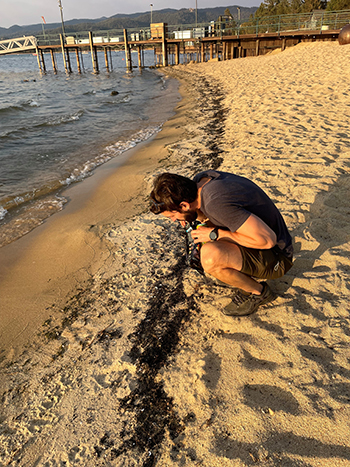LAKE TAHOE, CA/NV –– Even as flames from the Caldor Fire threatened Tahoe, scientific research efforts were already underway to learn how the historic blaze was impacting Lake Tahoe’s famed water quality and clarity. In the closing days of August, scientists from the bi-state Tahoe Science Advisory Council launched a rapid response scientific study to gather samples of smoke and ashfall from the Caldor Fire. That real-time data gathering is now supporting investigations into changes in algae growth, the presence of clarity-diminishing particles, and other ecological dynamics at play in the lake. The League to Save Lake Tahoe is the project’s lead funder, with additional support provided by the Tahoe Regional Planning Agency, the State of California, the State of Nevada, and the Tahoe Fund.
“The Caldor Fire is a wake-up call: climate change is here in Tahoe, and extreme wildfire is what it looks like. To Keep Tahoe Blue we need to adapt, and fast,” noted Darcie Goodman Collins, CEO of the League to Save Lake Tahoe, or Keep Tahoe Blue. “With this rapid response research, we’re pushing the boundaries of science to learn about wildfire impacts, help inform critical fire recovery decisions, and create a model that can be used in other places facing threats from extreme wildfire.”
The project’s funders and researchers highlighted the importance of turning the Caldor disaster into an opportunity to prepare for the future impacts of climate change. Armed with new science from the study, land managers and decision-makers can take steps to make Tahoe and the entire fire-threatened Sierra Nevada more resilient in the face of prolonged droughts and dry forests.
“We will need a multi-step process to understand the impacts of the Caldor Fire. A first step is to understand the impacts from the smoke and ash which have recently been deposited in the lake. As soon as the data is ready on how forest thinning and defensible space helped fire suppression, we’ll dive into that as well,” said Sudeep Chandra from the University of Nevada, Reno, one of the study’s leading scientists. “Fires like Caldor, Dixie, and Tamarack crossed county and even state lines, so the response must also be regional. Our science will help inform how to best restore the forests after a fire event, and what steps regional leaders should take to make Tahoe and the Sierra Nevada ecosystem resilient for the future.”
Prior studies indicate that wildfire smoke and ash can impact lake ecology by adding nutrient particles that promote algae growth, and by blocking ultraviolet light radiation which allows tiny invertebrates to migrate to the surface and feed on that algae. The combined impact, in the short-term at least, is reduced water clarity. The study will quantify those phenomena, while looking at previously unstudied impacts, including to nearshore water quality.
The University of Nevada, Reno, UC Davis Tahoe Environmental Research Center, and Desert Research Institute are all members of the Tahoe Science Advisory Council and collaborators in this study. The smoke and ash impacts research exemplifies the Council’s purpose – to be at the forefront of Tahoe scientific research when it is needed most. The present study will tie into the Council’s ongoing work to assess and preserve Lake Tahoe’s clarity.
The smoke and ash impacts research will continue in the coming months. Findings and recommendations will be shared with the public. Updates will be released at keeptahoeblue.org and tahoesciencecouncil.org.
###
Media resources: Photos
Media contacts:
Chris Joseph, League to Save Lake Tahoe (Keep Tahoe Blue)
cjoseph@keeptahoeblue.org, 530-208-5661
The League to Save Lake Tahoe, also known by its iconic slogan “Keep Tahoe Blue,” is Tahoe’s oldest and largest nonprofit environmental advocacy organization. Our team of solutions-oriented Tahoe advocates use innovation, boots-on-the-ground action, and a holistic approach to solve the environmental challenges threatening the lake we love. In our 64th year, we continue pushing to Keep Tahoe Blue in an ever-changing world. Learn more at keeptahoeblue.org.
Robert Larsen, Tahoe Science Advisory Council / CA Natural Resources Agency
robert.larsen@resources.ca.gov, 916-402-7508
The Tahoe Science Advisory Council (Council) is an independent group of scientists who work together in an advisory capacity to promote and enhance the use of the best available scientific information on matters of interest to both the states of California and Nevada. By bringing together representatives from all academic institutions and agencies, the Council aims to streamline and bridge all research and restoration basin-wide to leverage efforts and maximize resources. The Council was established in December 2015 by a memorandum of understanding between the Secretary of the California Natural Resources Agency, and the Director of the Nevada Department of Conservation and Natural Resources.


